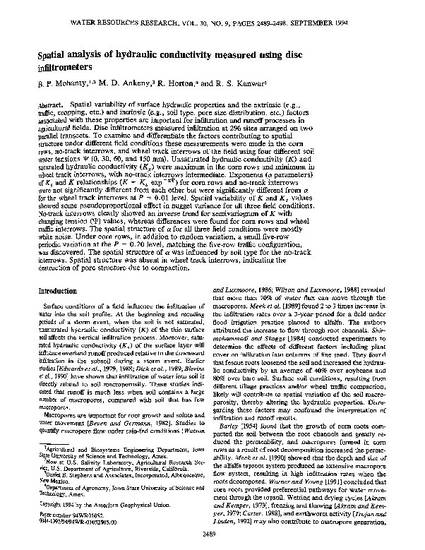
Spatial variability of surface hydraulic properties and the extrinsic (e.g., traffic, cropping, etc.) and intrinsic (e.g., soil type, pore size distribution, etc.) factors associated with these properties are important for infiltration and runoff processes in agricultural fields. Disc infiltrometers measured infiltration at 296 sites arranged on two parallel transects. To examine and differentiate the factors contributing to spatial structure under different field conditions these measurements were made in the corn rows, no-track interrows, and wheel track interrows of the field using four different soil water tensions Ψ (0, 30, 60, and 150 mm). Unsaturated hydraulic conductivity (K) and saturated hydraulic conductivity (Ks) were maximum in the corn rows and minimum in wheel track interrows, with no-track interrows intermediate. Exponents (α parameters) of Ks and K relationships (K = Ksexp−αΨ) for corn rows and no-track interrows were not significantly different from each other but were significantly different from a for the wheel track interrows at P = 0.01 level. Spatial variability of K and Ks values showed some pseudoproportional effect in nugget variance for all three field conditions. No-track interrows clearly showed an inverse trend for semivariogram of K with changing tension (Ψ) values, whereas differences were found for corn rows and wheel traffic interrows. The spatial structure of a for all three field conditions were mostly white noise. Under corn rows, in addition to random variation, a small five-row periodic variation at the P = 0.20 level, matching the five-row traffic configuration, was discovered. The spatial structure of α was influenced by soil type for the no-track interrows. Spatial structure was absent in wheel track interrows, indicating the destruction of pore structure due to compaction.
Available at: http://works.bepress.com/robert-horton/6/

This article was published in Water Resources Research 30 (1994): 2489–2498, doi:10.1029/94WR01052. Posted with permission.